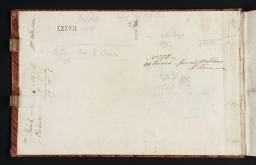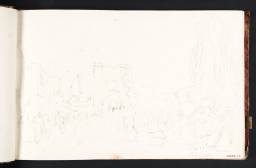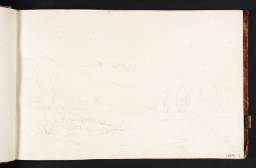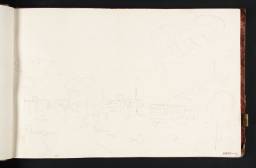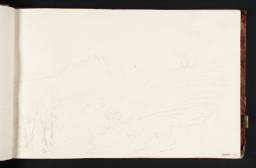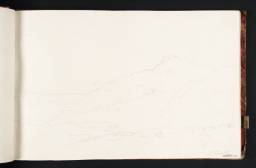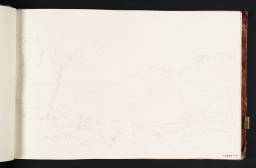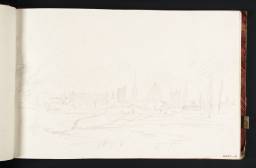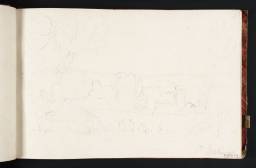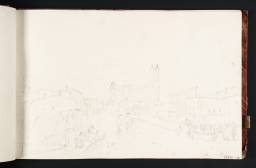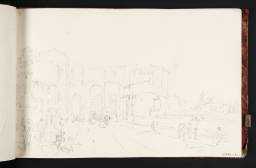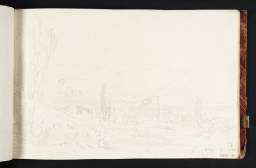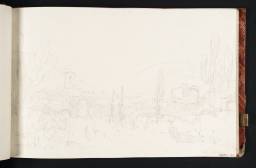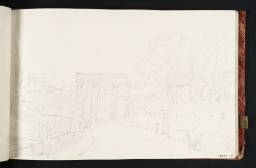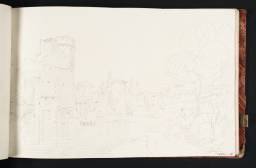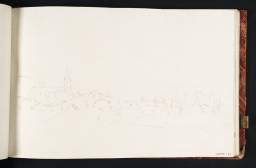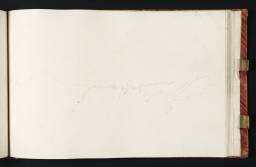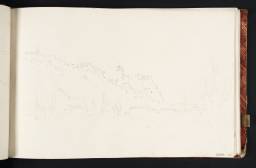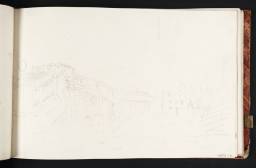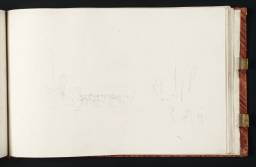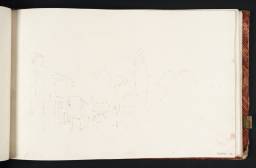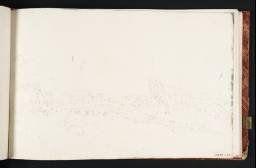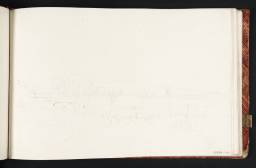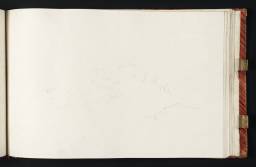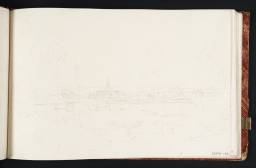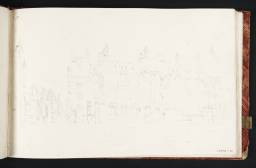Tate D04736–D04796; D40791–D40794
Turner Bequest LXXVII
Sketchbook bound in boards, covered with red comb-striped paper
49 leaves of white wove writing paper, made on a double-faced mould
Approximate page size 154 x 240 mm
Made by Johann Christoph de Rudolph Im-Hof, Basle, Switzerland. One leaf (folio 22, D04759) watermarked ‘IC DE R IMHOH’. Another (folio36, D04777) countermarked ‘GR MED’
Inscribed by Turner in ink ‘J M W T’ on the front cover (D40791) and ‘12’ on the spine
Numbered ‘273’ as part of the Turner Schedule, and endorsed by Henry Scott Trimmer, Executor of the Turner Bequest, in ink ‘49 leaves – pencil sketches. H.S. Trimmer’. Initialled in pencil by Charled Lock Eastlake ‘C.L.E.’ and by John Prescott Knight ‘JPK’. John Ruskin’s endorsement was recorded by Finberg; ‘273. Curious mixture of Lucerne, Basle and Oxford. Sketches of fine, simple style.’
49 leaves of white wove writing paper, made on a double-faced mould
Approximate page size 154 x 240 mm
Made by Johann Christoph de Rudolph Im-Hof, Basle, Switzerland. One leaf (folio 22, D04759) watermarked ‘IC DE R IMHOH’. Another (folio36, D04777) countermarked ‘GR MED’
Inscribed by Turner in ink ‘J M W T’ on the front cover (D40791) and ‘12’ on the spine
Numbered ‘273’ as part of the Turner Schedule, and endorsed by Henry Scott Trimmer, Executor of the Turner Bequest, in ink ‘49 leaves – pencil sketches. H.S. Trimmer’. Initialled in pencil by Charled Lock Eastlake ‘C.L.E.’ and by John Prescott Knight ‘JPK’. John Ruskin’s endorsement was recorded by Finberg; ‘273. Curious mixture of Lucerne, Basle and Oxford. Sketches of fine, simple style.’
Accepted by the nation as part of the Turner Bequest 1856
Exhibition history
References
Turner used this book during his first continental tour in 1802 (see Introduction, Sketchbooks from the Tour to Switzerland 1802) and afterwards in England. Although it was made in Basle, he may have bought it from a Berne paper maker. He used it on his return journey from Switzerland, first around Thun, then around Interlaken and Lake Brienz, at Grindelwald, the Reichenbach Falls, Lucerne, along the Rhine, at Basle and finally at Nancy and elsewhere on his return across France. He also used it in and around Oxford following his return home, and made three studies of historical compositions which relate to pictures painted later in the decade.
According to his own label on the spine, now removed but recorded by Finberg, Turner numbered the book ‘75’ and titled it ‘R. from Strasburg, Oxford’. David Hill notes that there are in fact no drawings of Strasbourg and that it is an ‘open question’ whether Turner meant the ‘R’ to denote ‘Route’ or ‘Rhine’. The original sequence of the drawings, and thus Turner’s exact itinerary and the identity of some subjects, was not preserved when John Ruskin broke up the book or at its subsequent rebinding (see below). Moreover, several leaves were removed and are still missing. As a result, the ‘curious mixture’ of subjects is more evident than it would have been to Ruskin himself. For example, there are groups of Rhine views on folios 1–7 (D04736–D04742) and French subjects from the castle of Blâmont to Nancy and Ligny-en-Barrois on folios 9–16 (D04744–D04751) which might be in something like their original order, but a view of Oxford intervenes on folio 8 (D04743).
The sketches remaining in the book are all in pencil. Most are of landscape or architectural subjects. Turner subsequently elaborated several in intermediate composition studies and developed these or others into watercolours for his patrons Walter Fawkes and Sir John Swinburne. On folio 27 is Turner’s first sketch of the Reichenbach Falls, made with the sketchbook turned upright; via an intermediate colour study (National Gallery of Ireland, Dublin)1 this produced a watercolour for Fawkes in 1804 (Cecil Higgins Art Gallery, Bedford).2 Folios 34 and 36 (D04774, D04777) of the lake and town of Brienz and Lucerne and the Rigi respectively are inscribed with the initial ‘F’, indicating commissions from Fawkes, but only the first of these reached completion in a finished watercolour (private collection).3 Sketches made around Lake Brienz proved especially fruitful. Folios 17 verso and 23 verso (D04753, D04761) ultimately led, by way of other material, to the watercolour Chateau de Rinkenberg, on the Lac de Brientz, Switzerland (Taft Museum, Cincinnati)4 made for Fawkes while folio 38 (D04780) was the origin of a view of the lake from the quay made for Swinburne (British Museum, London).5 Some of these and other subjects in the book were worked up in larger, intermediary studies in monochrome media in Turner’s Grenoble series which may have been shown to patrons as samples. In the case of a view of Grindelwald on folio 29 (D04768), a Grenoble version (Tate D04537; Turner Bequest LXXIV 44) was Turner’s only development of the spectacular scenery below the Eiger and Wetterhorn. He may have been rather overawed by it, although he made a number of drawings on the spot. These, together with those of Brienz, overlap with others in the Lake Thun sketchbook (Tate D04694–D04735; D40783–D40784; Turner Bequest LXXVI).
The views in or near Oxford may, as Colin Harrison suggests, have been made on the way to visit his relatives the Lovegroves and the Marshalls at Sunningwell, about four miles downstream from the city. Harrison notes that the sketches document a walk round Oxford, beginning on Magdalen Bridge, crossing to the fields on the south side of the London Road up Headington Hill and returning to Magdalen Bridge before continuing south-west and west to Sunningwell. Turner probably visited Oxford soon after his return to England, late in 1802 or the following year. Further motivations could have been his ongoing work providing head-pieces for the University’s calendar, the Oxford Almanack, and a project begun about this time for Thames Valley watercolours for engraving in William Byrne’s Britannia Depicta; views of Wycombe, from the Marlow Road and Eton, from the Slough Road were published in 1803. The travel expenses noted inside the front and back covers of the book (D40792, D40794) must relate to a trip along the Thames, while in Oxford itself Turner may have stayed, as he had in 1800, with ‘Williams the Engraver’, possibly John Williams of St Mary Hall-Lane; an account with ‘Mr Williams’ of a transaction for a picture and print is also noted inside the front cover.6
More problematic are the dating and subject of the historical sketches, folios 43 verso, 44 and 45 (D04787, D04788, D04789). As noted below, Ruskin thought all three were composition studies for Apollo and Python, exhibited at the Royal Academy in 1811(Tate N00488),7 but this is only certainly true of the first and does not establish the date as Turner seems to have had the theme in mind for much of the decade. Drawings of the subject or variants of it occur as early as in the Calais Pier sketchbook (Tate D04970, D04971; Turner Bequest LXXXI 68, 69), while other related sketches are in the Studies for Pictures: Isleworth sketchbook of about 1805 (Tate D05494; Turner Bequest XC 3) and the Hesperides I sketchbook (Tate D05813; Turner Bequest XCIII 28a). This last sketchbook contains ideas for The Goddess of Discord Choosing the Apple of Contention in the Garden of the Hesperides exhibited in 1806 (Tate N00477)8 to which the sketches on folios 44 and 45 of the present one have also been related, as well as to Apollo and Python. As The Goddess of Discord has a Swiss mountain background, Turner might have gone through this earlier sketchbook for suitable scenery around 1805 and added some historical sketches to the empty pages. On the other hand, there is no reason to date them much later than the others in the book on grounds of style.
John Gage ed., Collected Correspondence of J.M.W. Turner, Oxford 1980, p.21 note 2. For the 1800 visit, W.E. Frost and H. Reeve, A Complete Catalogue of the Paintings, Water-Colour Drawings and Prints in the Collection of the late H.A.J. Munro of Novar, London 1865, no.57.
Technical notes
How to cite
David Blayney Brown, ‘Rhine, Strassburg and Oxford sketchbook 1802–11’, sketchbook, March 2004, in David Blayney Brown (ed.), J.M.W. Turner: Sketchbooks, Drawings and Watercolours, Tate Research Publication, December 2012, https://www


